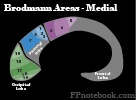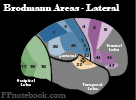Occipital Lobe, Occipital Lobe Function, Cerebral Occipital Lobe, Primary visual cortex, V1 Visual Cortex, Brodmann Area 17, Secondary Visual Cortex, V2 Visual Cortex, Brodmann Area 18, Associative visual cortex, V3 V4 and V5 Visual Cortex, Brodmann Area 19, Brodmann Areas of Occipital Lobe, Superior Occipital Gyrus, Lateral Occipital Gyrus, Inferior Occipital Gyrus, Lingual Gyrus, Cuneus
- Definitions
- Occipital Lobe
- Occipital Lobe primarily functions to receive and process visual input
- Brodmann Area 17 (V1) receives sensory input from the lateral geniculate nucleus in the Thalamus
- Subsequent signal processing
- Ventral stream (V2, Area 18) for form recognition and object representation
- Dorsal stream which processes motion and spatial orientation
- Further visual processing is performed in V4, a part of the Associative visual cortex (Area 19).
- Anatomy
- Brodmann Areas of Occipital Lobe
- Images
- Primary visual cortex (V1, Area 17)
- Receives sensory input from the lateral geniculate nucleus in the Thalamus.
- Lesions to this Primary visual cortex result in blindness of the contralateral Visual Field.
- Signals are then passed to the ventral stream (V2)
- Form recognition and object representation
- Signals are passed to the dorsal stream
- Processes motion and spatial orientation
- Secondary Visual Cortex (V2, Area 18)
- Part of the ventral stream, V2 receives visual input from the Primary visual cortex (V1)
- Processes the information for form recognition and object representation
- Also sends signals to the Associative visual cortex (V4) for further processing
- Associative visual cortex (V3, V4, V5, Area 19)
- Part of the ventral stream, V4 receives visual input from the Secondary Visual Cortex (V2)
- Further processes the information for form recognition and object representation
- Lesions to V4 will result in visual Agnosia (difficulty in object recognition)
- Exam
- Matches colors and objects (if unable to name them)
- Signs
- Brain Lesions
- Contralateral Hemianopia

